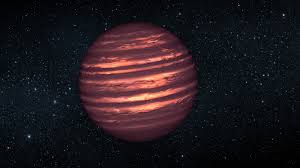Brown dwarf:

Scientists have puzzled over the object known as Gliese 229B, the first known brown dwarf discovered 30 years ago is actually twins orbiting each other.
- Brown dwarfs are sometimes called failed stars because they’re lighter than stars, but heavier than gas giant planets.
- These objects have a size between that of a giant planet like Jupiter and that of a small star.
- Brown dwarfs accumulate material like a star, not like a planet.
- They can also have clouds made out of precipitates in their atmospheres. However, while we have water clouds on Earth, the clouds on brown dwarfs are much hotter and likely made up of hot silicate particles.
- Thus, they hold onto their lighter elements (hydrogen and helium) more effectively than planets and have a relatively low metal content.
- They do not have enough massfor their cores to burn nuclear fuel and radiate starlight. This is why they are sometimes referred to as “failed stars.”
- The difference between brown dwarfs and stars is that, unlike stars, brown dwarfs do not reach stable luminosities by thermonuclear fusion of normal hydrogen.
- Both stars and brown dwarfs produce energy by fusion of deuterium (a rare isotope of hydrogen) in their first few million years.




